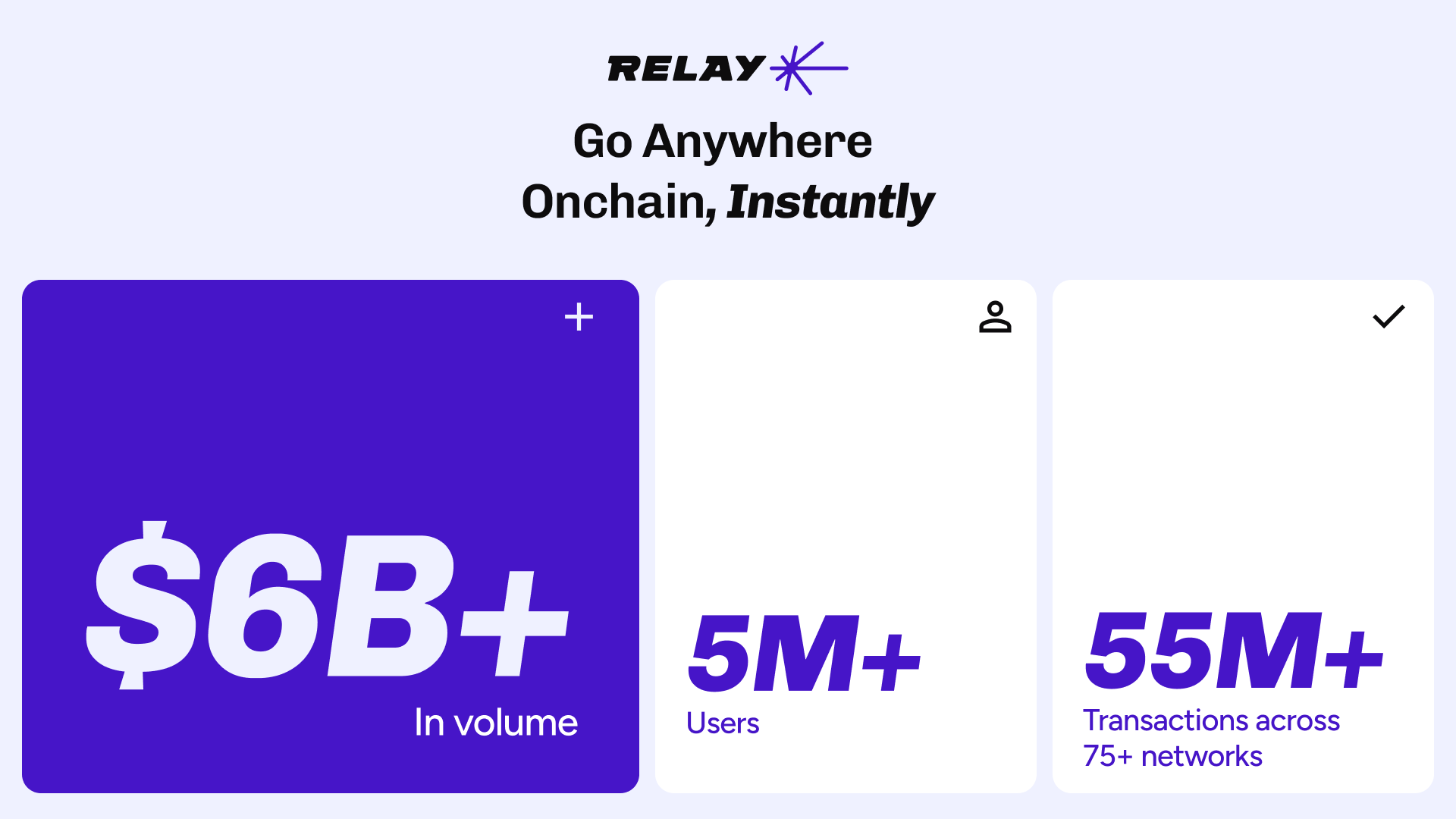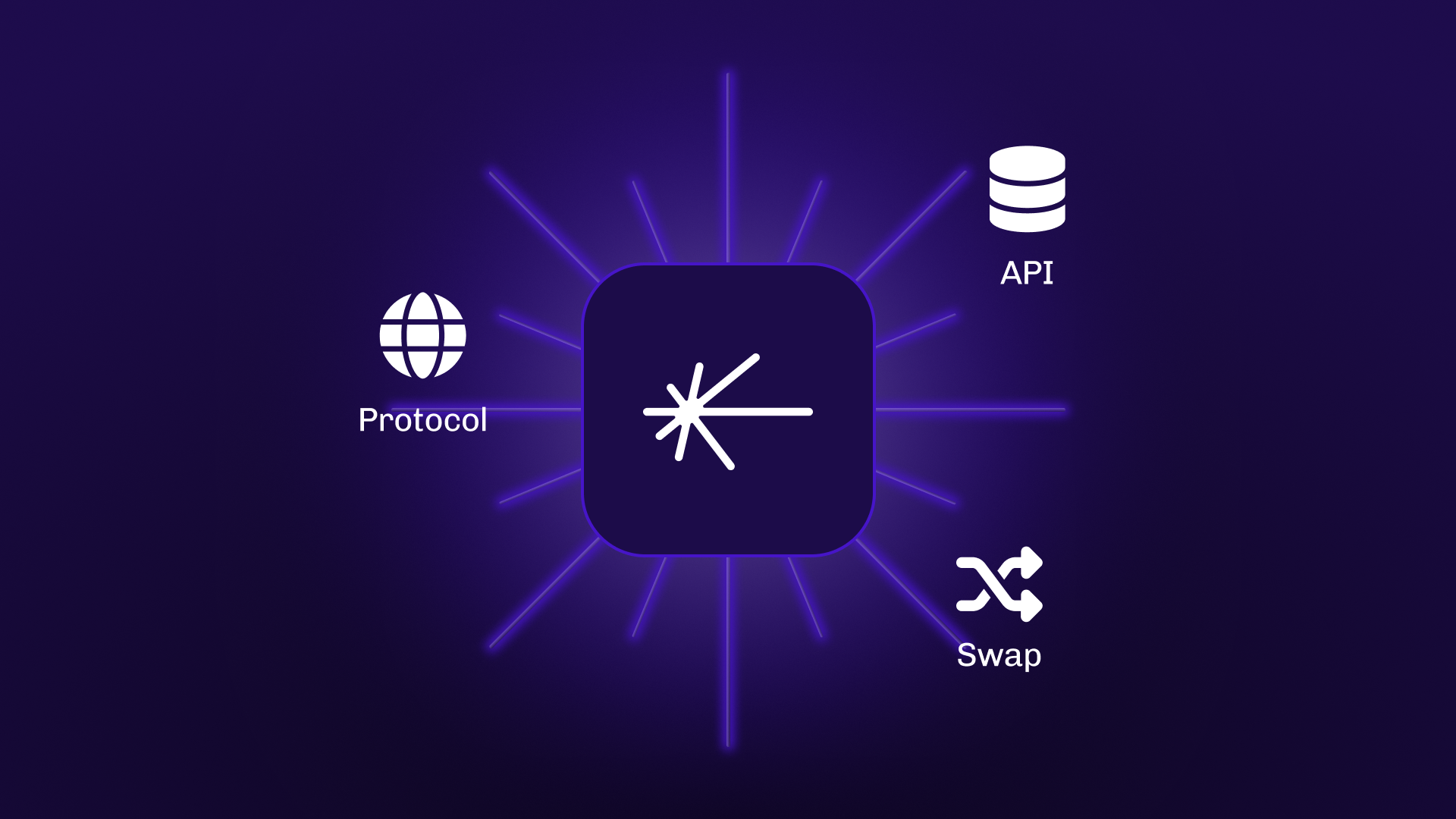Twelve months ago, most people saw bridging as a necessary evil - a clunky, expensive way to move tokens between chains when absolutely required. Today, we're processing over 3 transactions every block on Ethereum alone, representing nearly 0.7% of all network activity. What changed?
The answer lies in a fundamental shift we've been building toward: multichain payments. Not bridging as an afterthought, but payments designed from the ground up for a world where value moves fluidly across 75+ networks as easily as tapping to pay.

From Side Project to Transaction Fabric
Relay began as a humble solution to a specific problem: powering Zora's crosschain NFT minting. The goal was simple—let creators mint NFTs without forcing collectors to manually bridge funds or worry about which chain they were on.
That focus on invisible user experience unlocked something larger. As we expanded beyond NFTs to general-purpose crosschain transactions, the numbers told a story of pent-up demand:
- 5M+ users have transacted through Relay
- $5B+ in total volume moved across chains
- 50M+ transactions executed since launch
- 75+ networks connected through our infrastructure
But the real insight came from watching how our partners used our technology. Companies like OpenSea, Phantom, and Alchemy weren't just solving bridging problems - they were reimagining how value moves in crypto entirely.
Two Forces Reshaping the Crypto Landscape
Our explosive growth revealed two unstoppable trends that are fundamentally changing how we think about blockchain infrastructure:
The Multichain Explosion Is Accelerating
With Robinhood launching its own L2, Stripe and Paradigm backing new L1s, and over 1,000 active chains already in production, the future isn't consolidation—it's radical expansion. Every week brings new networks, each with unique capabilities and communities.
This isn't just about more chains existing. It's about value becoming truly fluid across ecosystems, with assets, users, and applications spanning multiple networks simultaneously.
Mass Adoption Demands Invisible UX
The average person will never manually calculate gas fees across networks or wait 20 minutes for confirmations. If crypto payments are harder than Venmo, we lose the next billion users.
This creates impossible tension: how do you deliver the simplicity users expect while navigating the complexity of a multichain world?
Our Solution: Payments-First Interoperability
Traditional bridging treats crosschain movement as an edge case—something that happens occasionally when users need to "go somewhere else." Multichain payments flip this assumption entirely.
Instead of optimizing for occasional crosschain movement, we've built infrastructure that assumes value naturally exists across multiple chains. Users shouldn't think about bridging any more than they think about which bank processes their credit card transaction.
Speed as a Reliability Feature
When we say Relay executes in milliseconds, not minutes, it's not just about user experience - it's about fundamental reliability. The faster a payment settles, the less room there is for price slippage, liquidity shifts, or transaction failures due to network changes.
Speed becomes a form of predictability. Users can trust that what they see is what they get.
Payments-Grade Infrastructure
We've built Relay with the same reliability expectations as traditional payment processors:
- 99.9% uptime across all supported networks
- Automatic failover systems that ensure execution even when primary paths break
- Clear completion signals that apps can depend on for user feedback
This isn't just about making transactions work - it's about making them work reliably enough that developers can build entire user experiences around them.
A Complete Stack for the Multichain Era
Delivering on this vision requires solutions at every layer of the payments experience:

Relay App serves as our flagship consumer experience—the fastest way to move from any token to any token across chains. It's built on the same infrastructure that powers our enterprise partners, demonstrating the capabilities developers can integrate.
Relay API abstracts away the complexity of chains and liquidity so developers can focus on building experiences. With one integration, apps get instant bridging across 75+ networks, meta-aggregated swapping across all major DEXs, and payments-grade features like fee sponsorship and guaranteed rates.
Relay Protocol provides the open infrastructure layer that connects users to relayers who perform onchain actions on their behalf. It's designed for low gas costs, rapid chain expansion, and maximum capital efficiency.
Real Impact Across the Ecosystem
This infrastructure is already powering some of the most important flows in crypto:
Chain expansion partners like Alchemy, Conduit, and Caldera rely on Relay to provide payment rails to every new rollup out of the box. When a new L2 launches, it automatically inherits connectivity to the entire multichain ecosystem.
Chain abstraction leaders like OpenSea use Relay to collapse complex crosschain workflows into single user actions. Collectors can mint NFTs or make purchases without thinking about chain boundaries.
Wallet innovators like Phantom integrate Relay to deliver seamless crosschain swaps that feel like native in-wallet operations.
The pattern is consistent: when developers stop thinking about bridging as a separate action and start building multichain payments into their core user flows, engagement and adoption increase dramatically.
What's Next: Scaling to the Edges
Relay 2.0 isn't just about improving what we've built - it's about scaling this vision to every corner of the crypto ecosystem. Our goal is ambitious but simple: every payment in crypto should be a multichain payment, and Relay should power them all.
This evolution starts with Relay Vaults, which will provide developers with new primitives for managing crosschain liquidity and execution. It continues with the full rollout of Relay Protocol, giving the ecosystem decentralized building blocks for instant, low-cost payments across every chain, wallet, and app.
The multichain era doesn't wait for perfect conditions. It begins when the right technology meets the right moment.
That moment is now.
